From The CRPG Addict
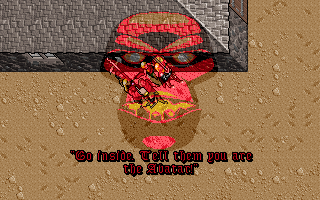 |
| Generally speaking, you probably shouldn’t do what menacing faces tell you to do. |
I begin this session on top of a flying carpet outside Castle Britannia, with the ability to go literally anywhere. But as I look over my growing “to do” list, I realize I am just addressing the symptoms of the many problems facing Britannia, not the sources. Centuries earlier, I stopped factional strife and spiritual ennui by undertaking the Quest of the Avatar, but as I reflect on what had happened since then, I realize that Britannia’s apex was not after the conclusion of the quest. In fact, I realize neither Lord British nor anyone else has ever provided me with an example of a problem that they solved with the Codex of Ultimate Wisdom. Finding the Codex, meanwhile, set in motion the rise of the Shadowlords and the destruction of the gargoyles.
Instead, the moral “golden age” of Britannia happened during the quest, when the thoughts of even average Britannians were alive with the power of virtue. When anyone who demonstrated that virtue could take a rune to the shrine and meditate on it. When the altars still thrummed with power at the bottoms of their dungeons. If you walked into Yew, the City of Justice, the citizens were thinking and talking about justice. The very first person I encountered in Trinsic, a random guard, had something to say about honor. But on this trip, the shrines are overgrown. No one can meditate at them because their talismans are kept in a museum. I don’t think a single person in Britain even mentioned the word “compassion,” nor did anybody in Trinsic talk about honor, except for the mayor, who said that Trinsic was “once the city of honor.” The cities have forgotten their virtues. The people are so wrapped up in what the Avatar accomplished in every other game that they’ve forgotten what made him the Avatar in the first place.
 |
| It’s time to return these to where they belong. |
I decide that it’s time to correct this problem, city by city, starting with returning the runes to the cities. I will find the person in each city who best embodies the city’s virtue and give him or her the associated rune. Then, my party will visit each shrine, meditate, and clean it up. Finally, we’ll clear out any dungeon infestations that had been allowed to creep up. (And, incidentally, make some money. Half of my “to do” items require money.) It’s time to show Britain what the virtues offer that the Fellowship doesn’t.
In times past, simply visiting the cities in the order of the virtues never failed me before, and such an order lines up well with my desire to see Mariah and Dupre earlier rather than later. Thus, after looting the museum for the eight runes, my party hops back onto the carpet, heading east for Moonglow.
On the way, however, we stop back at Cove. First, I want to give the Rune of Compassion to Nastassia. Second, I want to buy a few reagents from Rudyom. Third, I want to do something material for the kingdom by cleaning up Lock Lake.
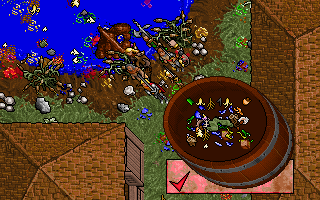 |
| Waste of time? Or authentic role-playing? |
After accomplishing the first two tasks, the party grabs an empty barrel from the tavern and takes it to the lakeshore. In a few minutes, we’ve filled it with trash, broken bottles, and dead animals. Unfortunately, there’s no way to physically pick up what looks like puddles of vomit around the lake, so the effect isn’t as striking as I hoped. Still, it’s a start. We have to leave half the lake until later, when we all have swamp boots.
During the process of moving around the lake, I discover that there’s a cave entrance north of Cove, guarded by a cyclops. You’d think someone in cove would have mentioned this. The cyclops outside of the cave is non-hostile, but I’m curious, so I have Spark light a torch, and we all enter the caves. We find a rather expansive network of them, wrapping through the mountains to the east and then south of Cove. They are filled with cyclopes, and unlike the one outside, they aren’t happy to see us.
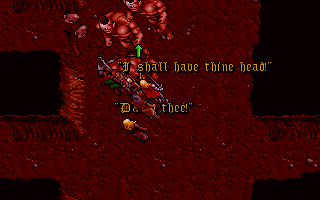 |
| Combat begins. |
Thus we engaged in our first successful combats of Ultima VII. Here’s how combat works. When you want to fight someone, you hit “C” and change to “combat mode.” At this point, each character has a certain percent chance of doing one of the following things:
- Shouting something like “Die, Knave!!!” and attacking the nearest enemy.
- Shouting something like “Die, Knave!!!” and attacking another party member.
- Shouting “AIEEEE!” and running away into some far corner, sometimes dropping items on the way.
- Shouting something like “I shall have thy blood!” and attacking some far off-screen enemy.
- Standing still and doing nothing for no reason.
- Standing still and doing nothing because the game inexplicably takes us out of combat mode even though I haven’t hit “C” again.
Now, that’s with the default set of actions. Theoretically, you can use a little button in the lower-left corner of the inventory to direct each character to attack the closest enemy, the strongest enemy, the weakest enemy, or a random enemy, to stand still and defend, to flank, to flee, to protect any other member that you engage with the “halo” icon, or to go “berserk” and never flee, although I don’t know how enemy selection works in that case. You can set the Avatar and only the Avatar for manual control, meaning he’ll attack whoever you double-click on.
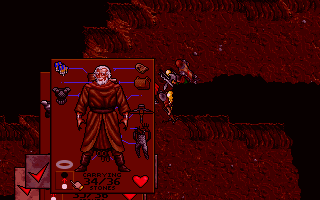 |
| Iolo is set here to fire his crossbow at the strongest enemy when combat begins. |
Truth be told, combat works a little better than those who lampoon the game like to admit. I jokingly suggested above that the characters might do any of a number of things once combat begins, but usually, they do what they’re supposed to do: attack according to their settings and flee if they’re damaged too much. Flanking admittedly produces some weird results, and characters often have odd interpretations of “strongest,” “weakest,” and “nearest.” Combat is over so fast that some of the fine-tune options like “protect” and “defend” are hard for the AI to follow. But in general it works about as well as Legend or Darklands or any game that has featured real-time-with-pause so far. With the default “strategies,” it’s not a million miles removed from the later Infinity Engine and its various combat scripts.
Part of the reason that combat seems so chaotic is that with eight characters, and their icons quite large, and their insistence on keeping a tight formation, it’s really hard to pick out one character from the mass. You have no visual feedback as to a character’s health, nor is there any summary screen that shows all the characters and their hit points. So if I want to know how Shamino, my fifth character, is doing, I have to hit the “Z” key five times, pulling up everyone else’s stats screens in order, until I finally find Shamino’s.
In fact, the visual chaos is such that it’s hard to tell when a character falls unconscious or dies. To check for a dead character, you literally have to open every “stats” window or every inventory screen, counting them, and noting if you seem to be one short. At that point, you can reload or haul the character to someone who can resurrect him, like Lord British. With Jaana in the party, I get resurrection and other healing services for free, which makes things awful easy–and yet I still typically reload when a character dies. It’s like I feel that a resurrected character is somehow tainted.
 |
| A couple of gold nuggets makes all the slaughter worth it. |
The worst part about combat in Ultima VII is the room respawn rate. The game essentially resets each room the moment it’s off-screen. My party could have literally killed cyclopes forever. While I like some limited respawning in games in case I have to grind, I also like to think I’m making some progress and that’s pretty hard when you kill a bunch of monsters, walk one screen away, walk back, and there they are alive again.
Our little war against the cyclopes gets us some experience and enough gold nuggets to trade back at the mint for a few hundred gold pieces, so it was worth it. Deep in the caves, we find some magical leggings and a lightning wand. I give the lightning wand to the character with the least experience–in this case, Jaana–and assign her to attack the strongest enemy. In a few hours, I’ll reassess.
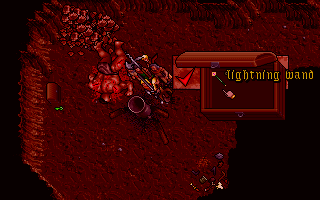 |
| Our reward for all that combat. |
Late in our explorations of the cyclops caves, we find a little fenced-in area with a chicken. There are a couple of pieces of furniture and stew pots. This makes us feel bad. The cyclopes are clearly semi-civilized creatures who I guess weren’t harming anyone until we wandered in. They did attack us first. You could argue that was because we’d burgled their home, but using that logic, I could never play a dungeon-crawling RPG again.
 |
| Nothing that keeps livestock ought to be slaughtered indiscriminately. |
We finally made our way out of the caves and back to the carpet. We left Cove. I note that if we had left cove on foot and wanted to avoid the poisonous swamps, we would have had to walk through the cyclops caves anyway, to their eastern exit.
It isn’t long in the air before we cross the mountains east of Cove and come to the city of Vesper. Here, the dock with The Golden Ankh awaits us. Now that we have the magic carpet, the ship is superfluous unless we need to visit an island that doesn’t have enough bare land for the carpet to land. Compared to previous Ultimas, ships here are so large that they’re almost comically awkward and yet still too small to really be considered “ships.” You have to lower the gangplank to board, then double-click on the mast to unfurl the sails and set it into motion. At this point, the characters take their seats.
The Isle of Fire, which I’m supposed to investigate at some point, is literally six moves from the docks. If I had one more ship, I could put them end-to-end like a bridge the way we used to do in Ultima II and IV. Anyway, I don’t have much use for the ship now, but we plunder its hold greedily for food.
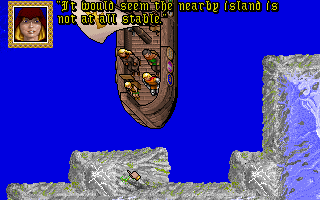 |
| We’ll deal with the Forge of Virtue eventually, but not today. |
The point of crisscrossing the continent, instead of going in a systematic order, is to investigate new things as we stumble upon them. I suppose we should investigate Vesper. The first building we encounter, just north of the docks, is the home of the trainer, Zaksam. It’s hard to tell if he’s a racist or just a realist. He tells stories of gargoyles robbing and burglarizing human residents and displaying a lot of aggression, and he’s worried that the gargoyles are eventually going to revolt. These fears might be founded, however, if rumors about gargoyles being given silver serpent venom is true. He decries more explicit racists like Blorn, so I don’t know.
More important, Zaksam is a trainer. Training is a tough thing to nail down in Ultima VII without resorting to spoilers. When characters increase in level, they get a certain number of training slots. There are a couple dozen trainers in the game who will increase strength, dexterity, intelligence, magic, or combat ability, or some combination of two or more of these attributes, in exchange for money. Each trainer requires a different number of training slots, between 1 and 3. Complicating things is the fact that combat ability increases on its own when strength and dexterity increase, so if you’re trying to keep a log of who increases what, it’s tough to separate direct gains from incidental gains–but maybe it doesn’t really matter.
 |
| Having Sentri provide free training right in front of Zaksam was probably rude. |
Sentri, who is in my party and will thus train us for free, requires one slot to increase dexterity by 1 and combat by 1. Since he only requires one slot, I suspect the combat increase is incidental to the dexterity increase. Zaksam requires three slots to increase strength by 1 and combat by 2. A player looking to min-max would, I guess, note all the trainers in the kingdom and then work out the most optimal plan. No one but the Avatar really needs intelligence or magic (and the events of Forge of Virtue override any training he gets from the main game anyway). But combat in the game isn’t that hard anyway. I think when I encounter a trainer, I’m just going to assess my party members, see who would benefit from his particular training, and go for it. For now, though, I don’t have quite enough money so the discussion is all moot. As for Sentri and his free training, I may take advantage of it eventually, but right now every single member of my party has higher dexterity than strength already.
Vesper is a town roiling in conflict between the humans and the gargoyles, who live on opposite sides of an oasis. Copies of the “send the gargoyles back!” flyer from the Britannian Purity League are in practically every human house, and several NPCs openly hand them to me when we talk. A couple of NPCs, such as Yongi the bartender and a local malcontent named Blorn, are openly racist. But even the best of them assume that the gargoyles will eventually revolt and slaughter them in their sleep. The spineless mayor, Auston, is rumored to be planning for such an eventuality.
 |
| This is one of the more reasonable NPCs in town |
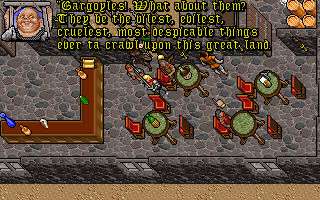 |
| The bartender’s take. |
On the gargoyle side, one of them named For-Lem has written a book called Thy Message Received that talks about the hatred and prejudice his people experience. A winged gargoyle named Wis-Sur used to be a wise sage but has retreated into himself in anger and paranoia. He screams at us, but with the right words, we can get him to sell spells and reagents.
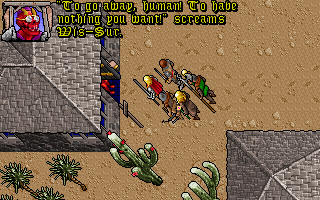 |
| That’s no way to run a store. |
The Avatar can’t do much about the troubles in town, and I arguably make things worse. As I approach the tavern on the gargoyle side of town, the Guardian’s voice tells me to go in and tell them that I am the Avatar. For some idiotic reason, I do as he says. This enrages the two wingless gargoyles drinking there, Anmanivas and Foranamo. They blame me for all of their problems and attack. The six of us have no trouble killing the two of them. None of the other gargoyles treat us any differently after the attack, but I still feel a bit bad because I’m mostly on the gargoyles’ side.
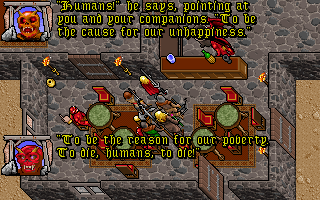 |
| It would be nice if everyone stopped blaming me for what happened to the gargoyles. |
The Britannian Mining Company runs a mineral mine on the north end of town. The overseer is Cador, a Fellowship member married to Yvella. They have a little girl named Catherine. The mine seems to employ only two other workers, a human named Mara and a gargoyle named Lap-Lem. I spend some time exploring the mines and kill some headless pretty deep within. There are two magically-locked doors that I cannot get past, one of which seems to have a chunk of blackrock behind it.
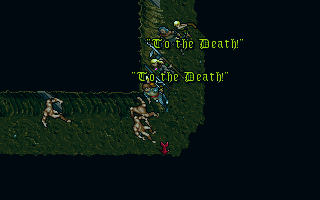 |
| The party charges some headless. |
Eldroth runs Eldroth’s Provisions. He has a way of mangling or rendering obvious old proverbs (“Early to bed, early to rise, makes Jack a dully boy”; “The best defense is a good defense”; “The early bird wakes up first.”). He also believes the gargoyles are going to revolt and says the mayor, Auston, is preparing for the inevitability. I don’t buy anything yet, but I note that he sells powder kegs, which have a lot of utility.
The only spark of hope of peace between the races comes in the form of the young girl Catherine. (She recognizes me as the Avatar immediately from pictures in her storybook.) Her mother is concerned about where she goes every day at noon. I follow her and find her in the house of the gargoyle For-Lem. It turns out he is teaching her gargoyle history and legends. He begs me not to tell her parents, and I agree.
 |
| To Catch a Gargoyle. |
There’s no sign of our old friend Sin’Vraal, who must have died in the past couple of centuries. I leave the town a bit depressed, headed for Moonglow.
Miscellaneous notes:
- Every time I start the game, I have to go through the title screens. Something has always seemed “off” to me about the “Lord British presents . . . ” screen. The background isn’t consistent with the style of the rest of the game, but that normally wouldn’t bother me. There’s something else about the color or pattern that makes me uncomfortable. Does anyone else feel it?
- Why does Jaana have a hawk?
- As with all games where this is true, it annoys me that you can’t see weapon damage values or armor protective values. Armor is somewhat easy to figure out, at least in terms of relative protective value, but the same isn’t true of weapons.
- The “Books of Britannia” entry has been updated with To the Death!, The Way of the Swallow, Gargoyle Like Me, Codavar, To Be or not to Be Thy Message Received, and That Beer Needs a Head on It.
 |
| Part of For-Lem’s Thy Message Received. |
- In previous games, where you had to type your keywords, NAME and JOB were useful just to get the conversation started. It was silly for ORIGIN to stick so stubbornly to them in this game, where you just click on keywords. We already made fun of the inanity of JOB when it comes to talking with children, but repeatedly in this game, someone will introduce themselves and then act all puzzled and wounded when you subsequently click on NAME. In a game where so much valuable information is delivered by dialogue, I’m going to click on everything. It would be nice if ORIGIN didn’t deliberately supply keywords that make you feel like a jackass for clicking on them.
- One question I never had answered in Vesper: Who owns the Britannian Mining Company?
- The watch the Avatar carries incorrectly displays the period between noon and 13:00 as “a.m.”
- If there was ever any real truth to the idea that wingless gargoyles are unintelligent, clearly that has changed in 200 years. There really seems to be no difference.
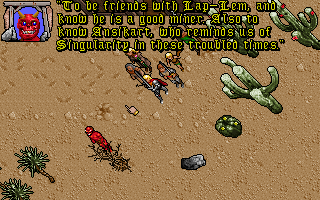 |
| The wingless For-Lem is a scholar of gargoyle history. |
Although I didn’t get very far along my master plan this session, I’m happy with what I accomplished. A little conversation, a little exploration, a little combat, and a little wealth acquisition is a better balance than the all-talk entries so far.
Before the next entry, let’s try to come up with a term to describe what I’m doing with the runes and shrines and with cleaning up Cove–silly things that the engine allows but that the game will never recognize.
Time so far: 15 hours
Original URL: http://crpgaddict.blogspot.com/2020/05/the-black-gate-be-change-you-want-to-see.html
